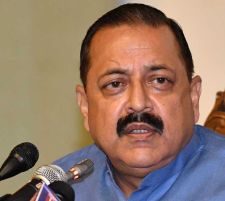MoS unveils ODAS Revamp-Parents and Teachers to join One Day Scientific Immersion
Published: Jul 26, 2025

By TIOLCorplaws News Service
NEW DELHI, JULY 26, 2025: HAILING the aspirational surge in youngsters, Union Minister Dr Jitendra Singh has said that the aspirations of India's youth must be met with 3 "A" - Awareness, Aptitude and Avenue.
The Minister underscored the need to channel the scientific enthusiasm among school students into sustained growth opportunities.
Speaking at the celebrations of the CSIR Jigyasa programme's "One Day as a Scientist" (ODAS) week at the CSIR-National Physical Laboratory, the Minister called for deeper engagement with students, schools, parents, and industry to shape the scientific future of India.
Building on that vision, Dr. Jitendra Singh suggested a series of refinements to the ongoing Jigyasa initiatives. First, he proposed involving parents directly in the ODAS experience-urging CSIR labs to invite at least one parent per participant so that families can better appreciate the value of scientific exploration. He stressed that such engagement would prevent students from being discouraged at home due to lack of understanding.
Second, Dr Jitendra Singh recommended a reciprocal model titled "One Day as a Teacher", where CSIR scientists visit the schools of participating students, especially those from smaller towns and rural areas. This, he said, would not only validate the achievements of the students but also inspire an entire school community.
Third, the Minister advised strengthening private sector involvement by encouraging industry partners-like those who supported the EPIC Hackathon-to adopt promising students or projects, providing mentorship and possibly financial support. This would help bridge the gap between school-level innovation and real-world application, he said.
Finally, the Minister encouraged the programme coordinators to continuously track student outcomes to better understand emerging interests and align future initiatives with evolving aspirations. These measures, he said, would help sustain the scientific momentum generated through ODAS and related programmes.
The ODAS initiative, inspired by Prime Minister Narendra Modi's call for students to experience life as a scientist, saw participation from over 14,000 students across 37 CSIR labs. Students shadowed researchers, conducted guided experiments, and interacted with experts in real laboratory environments.
Dr. Jitendra Singh recounted several moving interactions with young participants, including an eighth-grade girl from Dholpur who voiced concern over her younger sister's exclusion from the programme-an example, the Minister said, of the aspirational surge sweeping across India's youth.
A major highlight of the event was the felicitation of winners of the EPIC Hackathon 2024, an innovation competition conducted under the Jigyasa programme. The top four projects reflected a diverse mix of creativity, practicality, and scientific insight:
- Japteg Bamrah, a student from Pathankot, Punjab, bagged the top spot for developing SolarMech, a Stirling engine-based device that uses concentrated solar energy and thermodynamic principles to generate combined heat and power. His prototype, designed for maximum efficiency without the need for coolants, has potential applications in energy-scarce rural areas.
- Uddhav Gupta and Udbhav Bandhani, from Ghaziabad, secured second place for their project Drishyamitram-an Arduino-powered, smart walkway system for the visually impaired. It integrates sensor-based pedestrian detection, RFID navigation aids, and a mobile app, demonstrating how inclusive design and smart city tech can converge.
- Shreya Vinod, a student from Roorkee, won third place for creating a device that generates electricity from the waste heat of air conditioners using thermoelectric materials based on the Seebeck effect. Her system links six thermoelectric generators to convert thermal differentials into usable electric power-an idea with potential for energy-efficient buildings.
- Soyal Parija, from Bhubaneswar, also shared the third rank for I-Stetho, a wireless digital stethoscope that reduces physical contact between doctor and patient. The device captures sound, amplifies it, converts it into data, and transmits it to compatible devices-demonstrating the convergence of healthcare and Internet of Things (IoT) technology.
"These students are not just experimenting-they are innovating with confidence and clarity," said Dr. Jitendra Singh, who emphasised that such projects could be stepping stones toward sustainable entrepreneurship, provided they receive timely support and mentoring.
Launched in 2017, the CSIR Jigyasa programme has evolved into one of India's most expansive scientific outreach efforts. With over 13.5 lakh students and 80,000 teachers reached through more than 3,500 activities, it includes lab visits, virtual labs, ISL-enabled content, and innovation contests.
Dr. Jitendra Singh underlined how the New Education Policy 2020 supports programmes like Jigyasa by enabling subject flexibility and fostering inquiry-based learning. "Earlier, choices were forced. Now students can evolve with their interests-and Jigyasa gives them the platform to do so," he said.
As India looks toward its centenary in 2047, Dr. Jitendra Singh reiterated that the nation's greatest strength lies in its youth. "Stay curious, stay bold, and never stop asking questions," he urged, "because in every question lies the seed of discovery."
Joining Union Minister Dr. Jitendra Singh on the dais were Dr. N. Kalaiselvi, Director-General, CSIR & Secretary, DSIR; Dr. Geetha Vani Rayasam, Head, CSIR-HRDG; Prof. Venu Gopal Achanta, Director, CSIR-NPL; and Dr. D. Shailaja Donempudi, Scientist and Head, Business Development Group at CSIR, along with other senior officials and students from various colleges.




